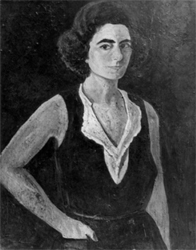
Slobodna Dalmacija is a Croatian daily newspaper published in Split.

Dugopolje is a municipality in Croatia in the Split-Dalmatia County.
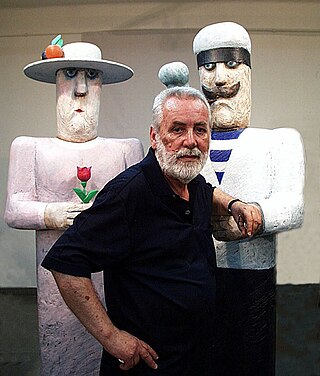
Vasko Lipovac was a Yugoslavian and Croatian painter, sculptor, printmaker, designer, illustrator and scenographer and one of the most prominent artists of the region. He is best known for his minimalist figuration and use of intense, unmodulated and often dissonant palette. With the exception of his juvenile period of geometric abstraction, he remained loyal to figuration throughout his whole career. Exceptionally prolific, he worked in various techniques and was equally skilful in using high-polished metal, polychromous wood, enamel, terracotta or polyester to create his sculptures, reliefs and mobiles.

The Split Metro is a suburban railway network in Split, Croatia. The railway was opened on refurbished existing M604 tracks on December 10, 2006. It consists of one line serving seven stations, running from Split centre to Kaštel Stari. The second line between Split centre and Split-Kopilica opened in June 2019, and was discontinued in November 2019. As of 2019, it is planned that new stations will be added along the tracks and the existing stops renovated. The line runs through two tunnels within the city centre of Split; within the longer of the two tunnels a metro-like station (Split-H.B.Z.) will be opened in 2021 to serve the city centre. The line is 17.8 kilometres (11.1 mi) long while an average train ride lasts for 25 minutes. A link with Split Airport and further extension to Trogir is considered, with possible electrification in the long-term.

Capital punishment was used from the creation of the modern Serbian state in 1804. On 26 February 2002, the Serbian Parliament adopted amendments striking the death penalty from the Criminal Code. The last execution, by shooting, took place on 14 February 1992, and the last death sentences were pronounced in 2001. Serbia is bound by the following international conventions prohibiting capital punishment : The Second Optional Protocol to the International Covenant on Civil and Political Rights, and Protocols No. 6 and No. 13 to the European Convention on Human Rights. According to Article 24 of the Serbian constitution (2006): „Human life is inviolable. There shall be no death penalty in the Republic of Serbia“.
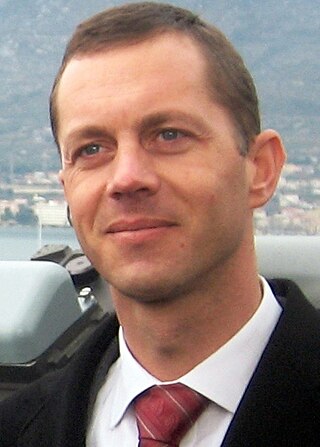
Ivan Kuret is a Croatian politician who served as the 69th Mayor of Split from 2007 to 2009.
Ivica Mlivončić was a Croatian author and columnist in Slobodna Dalmacija from Split. Born in Vareš, he graduated at the Faculty of Theology in Ljubljana, then at the Faculty of Political Sciences in Belgrade and the Faculty of Philosophy in Zadar. Mlivončić published several books dealing with religion, the Croatian War of Independence and the Croat–Bosniak War, most notably "The Crime with the Seal" in 1998 about war crimes against Croats, which was included in the Court records of the International Criminal Tribunal for the former Yugoslavia (ICTY). He was a defense witness at the ICTY in the case against Tihomir Blaškić in 1998. He died on 1 April 2013.

Grga Novak was a distinguished Croatian historian, archaeologist and geographer, and President of the Yugoslav Academy of Sciences and Arts from 1958 to 1978. Born on the island of Hvar, he was Professor of Ancient History in the University of Zagreb, where he was also Rector between 1946 and 1947. He is best known for pioneering archaeology in Croatia, and his publications on the history of Dalmatia, Split, Dubrovnik, Hvar and the Adriatic Islands.
Kazaginac is a village in the municipality of Tomislavgrad in Canton 10 of the Federation of Bosnia and Herzegovina in Bosnia and Herzegovina. The village is also part of the smaller Buško Blato micro-region, consisting of those villages and settlements surrounding the lake known as Buško jezero. According to the 2013 census, there were 277 inhabitants.

Izidor Perera-Matić was a Yugoslav physician and member of the Partisan resistance movement.
Emilio Stock (1868–1951) was an Italian industrialist and businessman of Jewish origin.
Lionello Stock (1866–1948) was an Italian industrialist, businessman and owner of the Camis & Stock company.

Prof. Dr. Jakob Altaras (1918–2001) was a Croatian-German physician and president of the Jewish community Giessen.
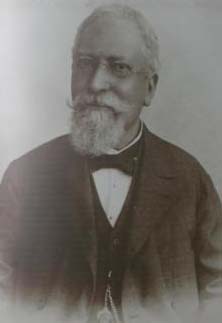
Vid Morpurgo (1838–1911) was a Dalmatian industrialist, publisher, politician and member of a notable Split family Morpurgo.
The following is a timeline of the history of the city of Split, Croatia.
The Classical Gymnasium was a gymnasium high school situated in Split, Dalmatia, Croatia. It was founded by the Austrian Empire and its Imperial Royal General Government in Dalmatia in 1817. Dalmatian Government, in fact, seceded the public part of the Archidiocesan Classical Gymnasium, founded by archbishop Stefano Cosmi in 1700.
ŽNK Split is a Croatian women's association football club based in Split. The club was founded in 2009 and it currently competes in the Croatian First Division. The club is the successor of ŽNK 8. mart, the first women's football club in Split, which was founded in 1971.
Stephanie Bukovec is a footballer who plays as a goalkeeper. Born in Canada, she represented the Croatia women's national team.

The Split Synagogue in Split, Croatia is one of the oldest Sefardic synagogue still in use today. It was built in the early 1500s.
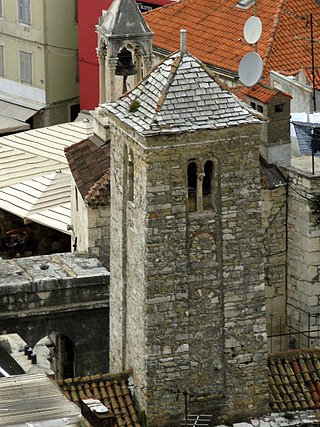
The Belltower of the Church of Our Lady of Zvonik is a disused Roman Catholic church in Split, Croatia. Built into a small space within the ancient Iron Gate of Diocletian's western wall. Today little survives of the building, apart from the belltower, one of the oldest in Croatia.
